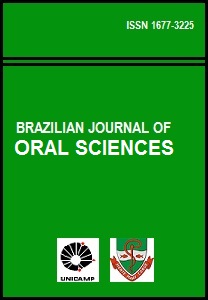Abstract
Aim: The objective of this study was to evaluate the bond strength of four dental ceramics to commercially pure titanium. Methods: To measure the resistance of metal-ceramic bonding, ceramic rings (Noritake Ti22®, Triceran®, IPS®, Noritake EX-3®) were made around metal rods fused to commercially pure titanium. The area of metal-ceramic union was measured and, after mounting in type III plaster, the rings were subjected to a shearing force in a universal testing machine at a crosshead speed of 2 mm/s until failure occurred. The metal-ceramic shear bond resistance was calculated in MPa. Results: The shear bond strength means for the ceramics Triceram and Noritake Ti22 (42.50 MPa and 61 MPa, respectively) were higher than the minimum value required by the DIN 13927 standard (25 MPa). The ceramics IPS and Noritake EX3, although not specifically formulated for titanium, also had shear bond strength means above the ISO-recommended value (38.47 MPa and 29.04 MPa, respectively); however, there cracks in some specimens after burning and detachment of the ceramic from the metal. Conclusions: The ceramic Noritake Ti22 should be indicated for the commercially pure titanium casting due to its higher mean bond resistance compared to other ceramics utilized.The Brazilian Journal of Oral Sciences uses the Creative Commons license (CC), thus preserving the integrity of the articles in an open access environment.
Downloads
Download data is not yet available.

